
You may notice scabs on your cat for a number of reasons, which can occur for a variety of reasons. Sometimes, there is no reason to be concerned. Other times, your cat may require a visit to the veterinarian for appropriate care.
Continue reading to learn about six typical causes of scabs on your cat.
The 6 Main Causes of Scabs on Cats
1. Fleas
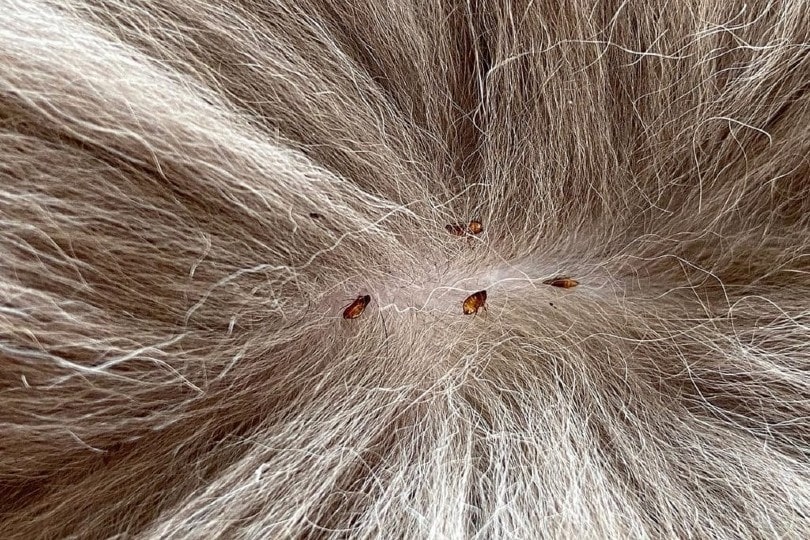
What you may notice
Many people think that their cat can’t have fleas because they haven’t seen any live fleas or the cat only stays inside. This is false! Fleas are extremely small, fast, and will often blend into the color of your cat’s fur and skin.
If your cat is not on a veterinary prescribed flea prevention, fleas are always on the list of causes of scabs on your cat. The scabs are typically from your cat scratching, biting, and licking themselves due to the itchiness of the fleas. Typically, cats will be itchy around the neck and near the tail and back legs. However, fleas can crawl anywhere, and your cat may just seem generally itchy.
What to do
Let’s start with what not to do, and that’s purchase any over-the-counter flea product for your cat. There are many products on the market for cats, which are extremely harmful. They can cause tremors, seizures, and even death. Even if the product sounds and looks safe, just don’t buy it. Only buy flea treatments and preventions from your veterinarian.
If your cat allows it, you can give them a bath with any type of unscented, undyed shampoo. Then, take your cat to the veterinarian to get a prescription product. Keep in mind that most cats will not allow a bath, and it may just be easier to make an appointment for them to see the vet.
2. Ear Infections or Ear Mites
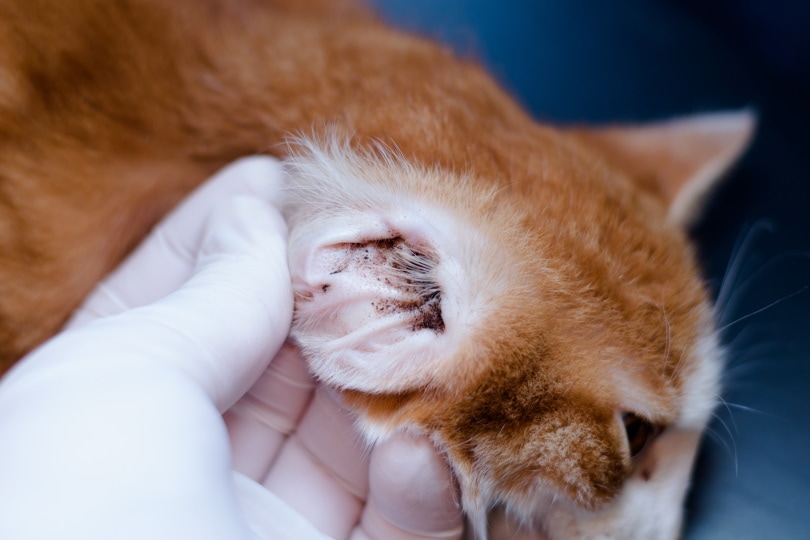
What you may notice
Your cat may be shaking their head, holding their ear(s) down, and or constantly scratching at their ear(s) with the back feet. You’ll notice scabbing and excoriations near the base of the ears, neck, and face. You may also notice an odor and/or discharge from one or both of your cat’s ears.
While ear mites are fairly common in outdoor cats and kittens, we don’t commonly see them in older and/or indoor cats. Older and/or indoor cats will more commonly develop ear infections from yeast, bacteria, and sometimes both.
What to do
Similar to our discussion about fleas, don’t buy any OTC products labeled for ear infections and/or ear mites in cats. These products often don’t contain any medications, but are just a combination of fruity scented liquids.
We also don’t recommend cleaning your cat’s ears with hydrogen peroxide, oil, vinegar, or other home remedies you may read about on the internet. These home products can be extremely irritating to your cat’s ears and may even cause damage to the ear drums, resulting in serious neurologic side deficits.
Take your cat to the vet so that they can properly diagnose your cat’s infection and get you appropriate medications.
3. Skin Infection (Pyoderma)
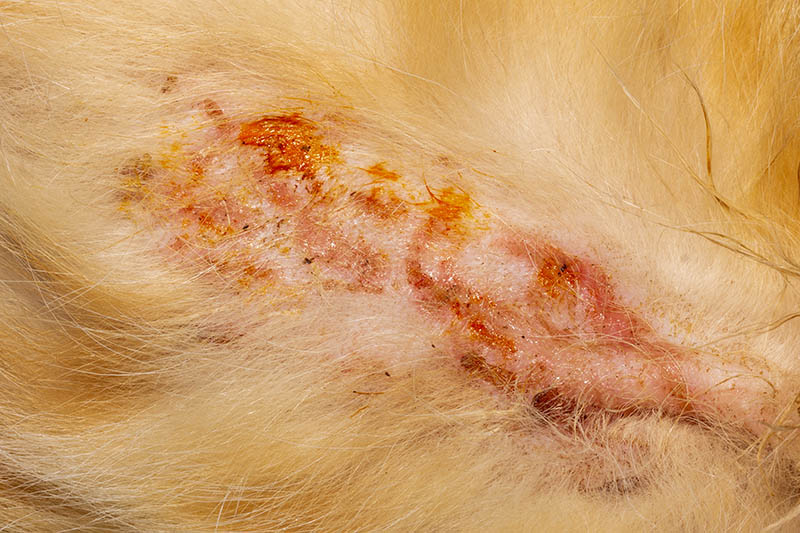
What you may notice
Scabs may form anywhere there is infection. These can be small, or larger, peeling crusts. Wherever there is a scab, your cat will be extremely itchy. You’ll notice them constantly trying to itch with their legs or chewing when you touch the scabs. Sometimes, your cat may lick the areas so much that the scabs become open, ulcerated, weeping wounds.
What to do: Place a baby t-shirt or an e-collar (the cone of shame) on your cat to help prevent them from further trauma. As stated above, a trip to the veterinarian is always recommended. Your cat will likely have to be on antibiotics to help clear the infection. Your vet can then prescribe or administer medications to help with the cause of the itching, as well as flea prevention and/or allergy medications.
4. Wounds
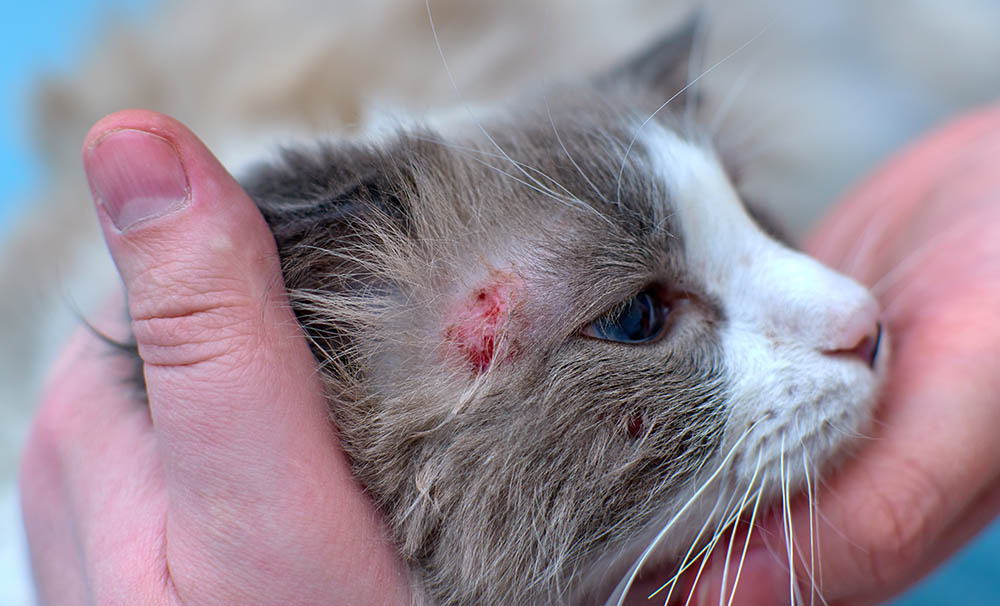
What you may notice
Scabs, cuts, scrapes, abrasions, and redness. Wounds are most common in outdoor only cats or indoor/outdoor cats—especially intact male cats who may be fighting over territory or mates.
Not all wounds are created equal. Some scabbing on a wound may be from mild skin irritation that has started to heal. Unfortunately, scabs on other wounds may be from discharge and infection that has developed within or around the wound.
What to do: Depending on where the wound is, you can put a baby t-shirt or an e-collar on your cat so that they don’t lick or chew the wound. If the wound is large, open, has an odor or any type of discharge, your cat should see the veterinarian.
If there are just a few skin scrapes but your cat seems otherwise unbothered, you likely don’t have to take them to the veterinarian. However, if you’re not sure, always contact your vet or send them a picture of the wound to be on the safe side.
5. Allergies
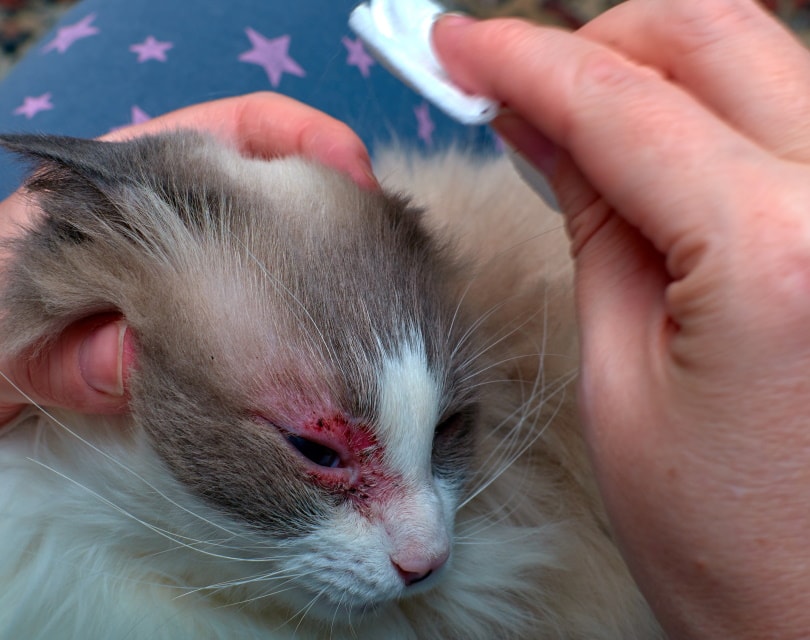
What you may notice
While some cats can develop watery eyes, nose, sneezing, and congestion from allergies, most will have itchy skin. You may notice your cat constantly scratching, licking, or chewing on their fur—much more than normal grooming. The trauma from your cat constantly itching at themselves may cause scabs in the most irritated areas.
What to do
Flea allergies are very common in cats. First, make sure your cat is on a prescribed flea treatment and prevention from your veterinarian. Absolutely do not purchase anything OTC. If your cat is still scabby and itchy despite using an appropriate product, make an appointment with your veterinarian. Assessing the areas where your cat is itchy and their lifestyle will help your veterinarian determine what types of allergies your cat is likely suffering from.
6. Stress and Over-grooming

What you may notice
Large bald patches, typically over the belly and underside of your cat, are common signs of scabbing related to stress and over-grooming. However, these bald areas can develop anywhere your cat is over-grooming. The hair in these areas is either completely gone or shortened. Scabs will form from your cat’s trauma to the area, or the hair being physically pulled out by your cat.
What to do
Stress reduction! Cats need safe places to hide, sleep, and relax. Make sure your cat has a nice cozy bed in their favorite sleeping spot, and nice comfy areas where they like to interact with the family. Adding in natural pheromone diffusers, such as Feliway, may also be effective. Speak with your veterinarian about other things you can do around the house or adding medications for your cat to help reduce stress.
Related read:
Summary
Cats can develop scabs on their skin from numerous things. Fleas, allergies, wounds, over-grooming, skin infections, and ear irritation are some of the more common reasons your cat may get scabs.
Most of the time, scabs are from your cat traumatizing their own skin from irritation. However, other scabs are from infection and wounds. Whatever the reason, make sure you try to prevent your cat from further irritating their skin and make an appointment to see the vet.
Featured Image Credit: Yaya Photos, Shutterstock






